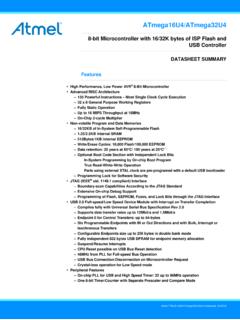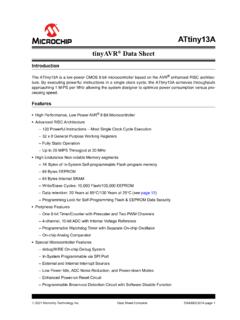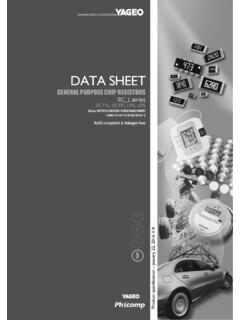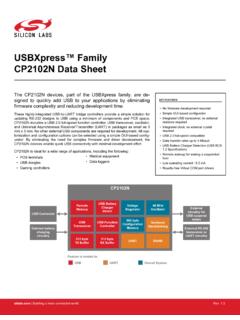Transcription of Low Power, Wide Supply Range, Low Cost Unity-Gain ...
1 Low Power, Wide Supply Range, Low Cost Unity-Gain Difference Amplifiers data sheet AD8276/AD8277 Rev. D Document Feedback Information furnished by Analog Devices is believed to be accurate and reliable. However, no responsibility is assumed by Analog Devices for its use, nor for any infringements of patents or other rights of third parties that may result from its use. Specifications subject to change without notice. No license is granted by implication or otherwise under any patent or patent rights of Analog Devices. Trademarks and registered trademarks are the property of their respective owners. One Technology Way, Box 9106, Norwood, MA 02062-9106, Tel: 2009 2019 Analog Devices, Inc. All rights reserved.
2 Te c hnical Support FEATURES Wide input range beyond supplies Rugged input overvoltage protection Low Supply current: 200 A maximum per channel Low power dissipation: mW at VS = V Bandwidth: 550 kHz CMRR: 86 dB minimum, dc to 10 kHz System offset voltage: 2 V/ C maximum (B Grade) Low gain drift: 1 ppm/ C maximum (B Grade) Enhanced slew rate: V/ s Wide power Supply range Single Supply : V to 36 V Dual supplies: 2 V to 18 V APPLICATIONS Voltage measurement and monitoring Current measurement and monitoring Differential output instrumentation amplifier Portable, battery-powered equipment Test and measurement general DESCRIPTION The AD8276/AD8277 are general - purpose , Unity-Gain difference amplifiers intended for precision signal conditioning in power critical applications that require both high performance and low power.
3 They provide exceptional 86 dB common-mode rejection ratio ( CMRR) and high bandwidth while amplifying signals well beyond the Supply rails. The on- chip resistors are laser trimmed for g ain drift of 1 ppm/ C and high CMRR. The AD8276/AD8277 also have extremely low gain drift vs. temperature. The common-mode range of the amplifiers extends to almost double the Supply voltage, making these amplifiers ideal for single- Supply applications that require a high common-mode voltage range. The internal resistors and electrostatic discharge (ESD) circuitry at the inputs also provide overvoltage protection to the op amps. The AD8276/AD8277 are u nity-gain stable. Although they are optimized for use as difference amplifiers, they can also be connected in high precision, single-ended configurations with G = 1, +1, or +2.
4 The AD8276/AD8277 provide an integrated precision solution that has smaller size, lower cost, and improved performance than a discrete alternative. The AD8276/AD8277 operate on single supplies ( V to 36 V) or dual supplies ( 2 V to 18 V). The maximum quiescent Supply current is 200 A per channel, which is ideal for battery-operated and portable systems. FUNCTIONAL BLOCK DIAGRAMS 07692-001253167440k 40k 40k VS+VS IN+INSENSEOUTREF40k AD8276 Figure 1. AD8276 07692-052212314131140k 40k 40k +VS INA+INASENSEAOUTAREFA40k AD8277610589440k 40k 40k VS INB+INBSENSEBOUTBREFB40k Figure 2. AD8277 The AD8276 is available in the space-saving 8-lead mini small outline package (MSOP) and the standard small outline (SOIC) package, as well as in die form, and the AD8277 is offered in a 14-lead SOIC package.
5 Both are specified for performance over the industrial temperature range of 40 C to +85 C and are fully RoHS compliant. Table 1. Difference Amplifiers by Category Low Distortion High Voltage Current Sensing1 Low Power AD8270 AD628 AD8202 (U) AD8276 AD8271 AD629 AD8203 (U) AD8277 AD8273 AD8205 (B) AD8278 AD8274 AD8206 (B) AMP03 AD8216 (B) 1 U means unidirectional, B means bidirectional. AD8276/AD8277 data sheet Rev. D | Page 2 of 22 TABLE OF CONTENTS Features .. 1 Applications .. 1 general Description .. 1 Functional Block Diagrams .. 1 Revision History .. 2 Specifications .. 3 Absolute Maximum Ratings .. 5 Thermal Resistance .. 5 Maximum Power Dissipation .. 5 Short-Circuit Current .. 5 ESD Caution .. 5 Pin Configurations and Function Descriptions.
6 6 Typical Performance Characteristics .. 8 Theory of Operation .. 14 Circuit Information .. 14 Driving the AD8276/AD8277 .. 14 Input Voltage Range .. 14 Power Supplies .. 15 Applications Information .. 16 Configurations .. 16 Differential Output .. 16 Current Source .. 17 Vo ltage and Current Monitoring .. 17 Instrumentation 18 RTD .. 18 Die Information .. 19 Die Specifications and Assembly Recommendations .. 19 Outline Dimensions .. 20 Ordering Guide .. 22 REVISION HISTORY 11/2019 R e v. C to R e v. D Changes to general Description .. 1 Changes to Thermal Resistance Section .. 5 Added Figure 6 and Ta b l e 7; Renumbered Sequentially .. 6 Changes to Current Source Section and Figure 50 .. 17 Added Die Information Section, Die Specifications and Assembly Recommendations Section, Ta b l e 10, and Ta b l e 11.
7 19 Updated Outline Dimensions .. 20 Changes to Ordering Guide .. 22 11/2011 Re v. B to R e v. C Change to Figure 53 .. 18 4/2010 R e v. A to R e v. B Changes to Figure 53 .. 18 Updated Outline Dimensions .. 19 7/2009 Re v. 0 to Rev. A Added AD8277 .. Universal Changes to Features Section .. 1 Changes to general Description Section .. 1 Added Figure 2; Renumbered Sequentially .. 1 Changes to Specifications Section .. 3 Changes to Figure 3 and Table 5 .. 5 Added Figure 5 and Table 7; Renumbered Sequentially .. 7 Changes to Figure 10 .. 8 Changes to Figure 34 .. 12 Added Figure 36 .. 13 Changes to Input Voltage Range Section .. 14 Changes to Power Supplies Section and Added Figure 40 .. 15 Added to Figure 40 .. 15 Changes to Differenti al Output Section.
8 16 Added Figure 47 and Changes to Current Source Section .. 17 Added Voltage and Current Monitoring Section and Figure 17 Moved Instrumentation Amplifier Section and Added RTD Section .. 18 Changes to Ordering Guide .. 20 5/2009 Revision 0: Initial Version data sheet AD8276/AD8277 Rev. D | Page 3 of 22 SPECIFICATIONS Supply voltage (VS) = 5 V to 15 V, reference voltage (VREF) = 0 V, TA = 25 C, load resistance (RL) = 10 k connected to ground, G = 1 difference amplifier configuration, unless otherwise noted. Table 2. Grade B Grade A Parameter Test Conditions/Comments Min Typ Max Min Typ Max Unit INPUT CHARACTERISTICS System Offset1 100 200 100 500 V vs. Te mperature TA = 40 C to +85 C 200 500 V Average Temperature Coefficient TA = 40 C to +85 C 2 2 5 V/ C vs.
9 Power Supply VS = 5 V to 18 V 5 10 V/V Common-Mode Rejection Ratio Reference to Input (RTI) VS = 15 V, common-mode voltage (VCM) = 27 V, series resistance (RS) = 0 86 80 dB Input Voltage Range2 2(VS + ) +2(VS ) 2(VS + ) +2(VS ) V Impedance3 Differential 80 80 k Common Mode 40 40 k DYNAMIC PERFORMANCE Bandwidth 550 550 kHz Slew Rate V/ s Settling Time to 10 V step on output, load capacitance (CL) = 100 pF 15 15 s Settling Time to 16 16 s Channel Separation f = 1 kHz 130 130 dB GAIN Gain Error % Gain Drift TA = 40 C to +85 C 1 5 ppm/ C Gain Nonlinearity Output voltage (VOUT) = 20 V p-p 5 10 ppm OUTPUT CHARACTERISTICS Output Voltage Swing4 VS = 15 V, RL = 10 k , TA = 40 C to +85 C VS + +VS VS + +VS V Short-Circuit Current Limit 15 15 mA Capacitive Load Drive 200 200 pF NOISE5 Output Voltage Noise f = Hz to 10 Hz 2 2 V p-p f = 1 kHz 65 70 65 70 nV/ Hz POWER Supply Supply Current6 200 200 A vs.
10 Temperature TA = 40 C to +85 C 250 250 A Operating Voltage Range7 2 18 2 18 V TEMPERATURE RANGE Operating Range 40 +125 40 +125 C 1 Includes input bias and offset current errors, referred to output (RTO). 2 The input voltage range can also be limited by the absolute maximum input voltage or by the output swing. See the Input Voltage Range section in the Theory of Operation section for details. 3 Internal resistors are trimmed to be ratio matched and have 20% absolute accuracy. 4 Output voltage swing varies with Supply v oltage and temperature. See Figure 19 through Figure 22 for details. 5 Includes amplifier voltage and current noise, as well as noise from internal resistors. 6 Supply current varies with Supply voltage and temperature.


















